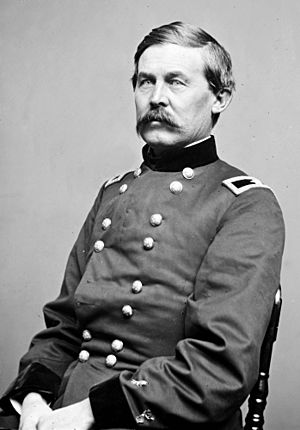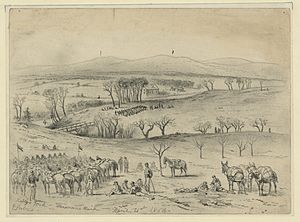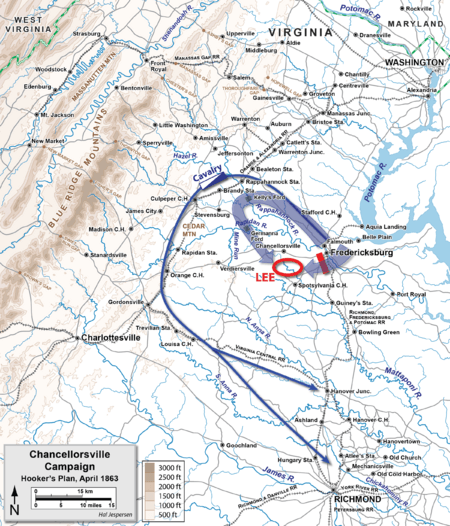Stoneman's 1863 raid facts for kids
Quick facts for kids Stoneman's 1863 raid |
|||||||
|---|---|---|---|---|---|---|---|
| Part of the American Civil War | |||||||
|
|||||||
| Belligerents | |||||||
| Commanders and leaders | |||||||
| Major General George Stoneman | General Robert E. Lee | ||||||
| Strength | |||||||
| ? | ? | ||||||
| Casualties and losses | |||||||
| ? | ? | ||||||
Stoneman's Raid was a military operation during the American Civil War. It involved Union cavalry soldiers led by General George Stoneman. This raid happened just before the big Battle of Chancellorsville.
The main goal of the raid was to cut off supplies for the Confederate army. It aimed to disrupt their ability to fight.
Contents
Planning the Cavalry Attack
In April 1863, Union Major General Joseph Hooker wanted to move the Confederate army. He planned to force General Robert E. Lee's troops away from Fredericksburg.
Hooker sent Major General George Stoneman and about 10,000 cavalry soldiers. Their mission was to ride behind Lee's army. They aimed to get between Lee and the Confederate capital, Richmond.
Stoneman's main task was to destroy the Orange and Alexandria Railroad. This railroad was very important for Confederate supplies. Hooker hoped this would make Lee's army leave Fredericksburg. It would also cut off their food and other needs.
Hooker also made sure John Buford had an active role. Buford led a special group of cavalry units.
Getting Ready for the Raid
On April 13, 1863, Buford's cavalry group began their daring mission. They left their camp in Falmouth, Virginia. The very next day, they met Confederate soldiers at Kelly's Ford.
The Confederates fired cannons, but the Union soldiers fired back. They managed to push the enemy guns away. By April 15, Buford's group was ready to cross the Rappahannock River.
However, heavy rain made the roads muddy and streams flooded. The bad weather delayed their plans. It wasn't until April 29 that they could finally cross at Kelly's Ford.
Buford wrote about the terrible conditions during those two weeks:
- "The ford was swimming."
- "The country was like a sea."
- "Roads were in a worse condition than I could have supposed."
- "The command was called upon to endure much severe discomfiture."
The Raid Begins

From April 29 to 30, Buford's cavalry searched for river crossings. They also had small fights with Confederate guards. The weather stayed bad, and the soldiers' food got wet. They couldn't light campfires, so their uniforms were rarely dry.
The horses suffered even more. Dead and injured animals were left along Stoneman's path. By May 2, Buford's group was camped near the North Anna River. They were almost halfway to the Confederate capital, Richmond. Now they could start destroying local buildings and railroads.
On May 2, Captain Myles Keogh led a raid with Lieutenant Walker's company. They captured a supply train with 15 wagons at Thompson's Cross Roads. Keogh made sure the captured mules were given to soldiers whose horses were tired.
Captain Lord also led his regiment to destroy parts of the railroad. They burned a bridge over the North Anna River.
Facing the Enemy
On May 4, Captain Harrison's cavalry group met Confederate cavalry. These enemy soldiers were led by Robert E. Lee's son, Rooney Lee. Captain Harrison reported that his small group faced a much larger force.
He described the fight:
- "My force was 30 men."
- "The rebel force was at least 1,000 men."
- "I made up my mind to charge them."
- "The shock of the charge was so great that my foremost horses were completely knocked over."
- "I fought them as long as I deemed prudent."
- "I was overpowered by numbers, I wheeled about and retreated."
By May 5, only 646 of Buford's horses were strong enough to continue. Buford returned to Louisa and Gordonsville. He found that the damage they had done three days earlier was partly repaired. Buford's men started destroying things again. That night, they met a strong group of Confederate soldiers and cannons. One soldier said, "it looked...as if our time had come."
Buford's return was also a trick to hide the main cavalry group's return. Colonel George B. Sandford later said Buford was the best person for such a task. For three days and nights, Buford's tired men kept moving. Many soldiers fell asleep while riding their exhausted horses. Even as the mission ended, they still had to cross flooded rivers.
After the Raid
From May 6 to May 10, Buford's men slowly returned to their headquarters in Falmouth. They rested and went back to their regular duties. Buford's actions were one of the few good parts of the raid. Even though the raid didn't cause as much damage as hoped, the Northern newspapers praised it.
General Hooker felt Stoneman was partly to blame for the Union's loss at Chancellorsville. So, Hooker removed Stoneman from his cavalry command. Stoneman was sent to Washington, D.C., for medical reasons. He later got a desk job as Chief of the U.S. Cavalry Bureau.
Buford was promoted to lead a cavalry division. He praised his staff in his official report. He said they worked hard and helped him a lot.
Even though the raid had mixed results, it made the Union cavalry feel more confident. One soldier said, "It was ever after a matter of pride with the boys that they were on Stoneman's Raid."
|




